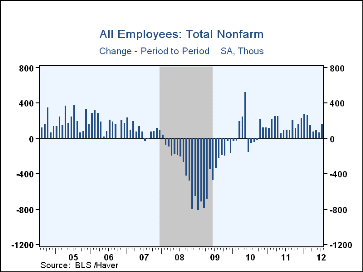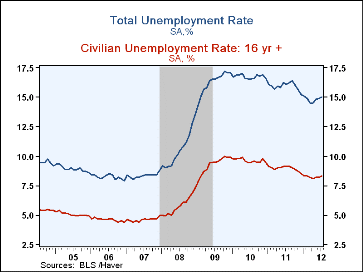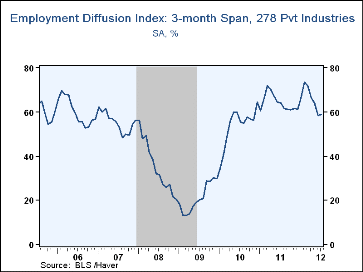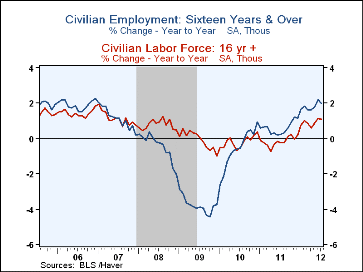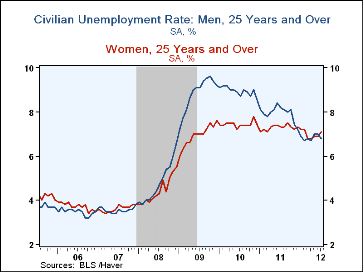 Global| Aug 03 2012
Global| Aug 03 2012U.S. Nonfarm Payroll Growth Picks Up; Jobless Rate Is Higher
by:Tom Moeller
|in:Economy in Brief
Summary
Nonfarm payrolls grew an improved 163,000 last month following a 64,000 June rise, revised from 80,000. A 100,000 increase was expected. Improved job growth in manufacturing and private services accounted for the gain. The [...]
Nonfarm payrolls grew an improved 163,000 last month following a 64,000 June rise, revised from 80,000. A 100,000 increase was expected. Improved job growth in manufacturing and private services accounted for the gain. The unemployment rate ticked higher to 8.3% versus expectations for 8.2%.
From the establishment survey, a 163,000 increase in jobs was the firmest since February. However, just 56.4% of private industries added to employment roles last month, the least since November 2011. Over the last three months that percentage was 58.8%, the least since November 2010.
The manufacturing sector added 25,000 jobs following gains of roughly half that during the prior three months. In private service industries, employment grew 148,000 (1.8% y/y). The greatest improvement versus earlier months came in professional & business services where jobs increased 49,000 (3.4% y/y), education & health where hiring rose 38,000 (2.1% y/y) and leisure & hospitality where employment grew 27,000 (2.2% y/y). Temporary help services jobs also were firm posting a 14,100 increase (10.6% y/y). Construction jobs fell 1,000 (+0.1% y/y), down for the fifth month in the last six. Public sector hiring continued to decline. Last month's 9,000 drop (-0.5% y/y) was led by 6,000 (-0.0% y/y) fewer state gov't workers and 2,000 (-1.3% y/y) less federal government employees. Local gov't employment fell 1,000 (-0.5% y/y).
Average hourly earnings ticked up just 0.1% (1.3% y/y) following June's 0.3% increase. Moderate gains were broadly in evidence across sectors.
From the household survey, the unemployment rate nudged up to 8.3%, its highest level since February. The increase came as employment fell 195,000 (+2.0% y/y) after two months of increase. That decline outpaced the 150,000 drop (+1.1% y/y) in the labor force which also followed two months of increase. The labor force participation rate declined to 63.7%, its lowest since April. The number of potential workers not in the labor force grew 2.3% y/y, down from 2.5% growth last year and 2.9% in 2010.
The length of time unemployed is shortening. The average length of unemployment fell to 38.8 weeks, its least since February of last year. The percentage of workers out of work for 52 weeks or longer fell to 27.3%, its least since March 2010. Gender matters: The unemployment rate for men aged 25 and older fell to 6.8% last month versus 7.9% during all of last year and 8.9% in 2010. For women aged 25 and older the unemployment rate of 7.1% compared to 7.3% last year and 7.4% in 2010.
The figures referenced above are available in Haver's USECON database. Additional detail can be found in the LABOR and in the EMPL databases. The expectation figures are from Action Economics and are in the AS1REPNA database.
| Employment: (M/M Chg., 000s) | Jul | Jun | May | Y/Y | 2011 | 2010 | 2009 |
|---|---|---|---|---|---|---|---|
| Payroll Employment | 163 | 64 | 87 | 1.4% | 1.2% | -0.7% | -4.4% |
| Previous | -- | 80 | 77 | -- | -- | -- | -- |
| Manufacturing | 25 | 10 | 13 | 1.9 | 1.8 | -2.7 | -11.6 |
| Construction | -1 | 4 | -32 | 0.1 | -0.3 | -8.2 | -16.0 |
| Private Service Producing | 148 | 60 | 131 | 1.8 | 1.8 | -0.1 | -3.5 |
| Government | -9 | -9 | -29 | -0.5 | -1.7 | -0.3 | 0.2 |
| Average Weekly Hours - Private Sector | 34.5 | 34.5 | 34.4 | 34.4 (Jul'11) |
34.4 | 34.1 | 33.9 |
| Average Private Sector Hourly Earnings (%) | 0.1 | 0.3 | 0.1 | 1.7 | 2.0 | 2.4 | 3.0 |
| Unemployment Rate (%) | 8.3 | 8.2 | 8.2 | 9.1 (Jul'11) |
9.0 | 9.6 | 9.3 |
Tom Moeller
AuthorMore in Author Profile »Prior to joining Haver Analytics in 2000, Mr. Moeller worked as the Economist at Chancellor Capital Management from 1985 to 1999. There, he developed comprehensive economic forecasts and interpreted economic data for equity and fixed income portfolio managers. Also at Chancellor, Mr. Moeller worked as an equity analyst and was responsible for researching and rating companies in the economically sensitive automobile and housing industries for investment in Chancellor’s equity portfolio. Prior to joining Chancellor, Mr. Moeller was an Economist at Citibank from 1979 to 1984. He also analyzed pricing behavior in the metals industry for the Council on Wage and Price Stability in Washington, D.C. In 1999, Mr. Moeller received the award for most accurate forecast from the Forecasters' Club of New York. From 1990 to 1992 he was President of the New York Association for Business Economists. Mr. Moeller earned an M.B.A. in Finance from Fordham University, where he graduated in 1987. He holds a Bachelor of Arts in Economics from George Washington University.


